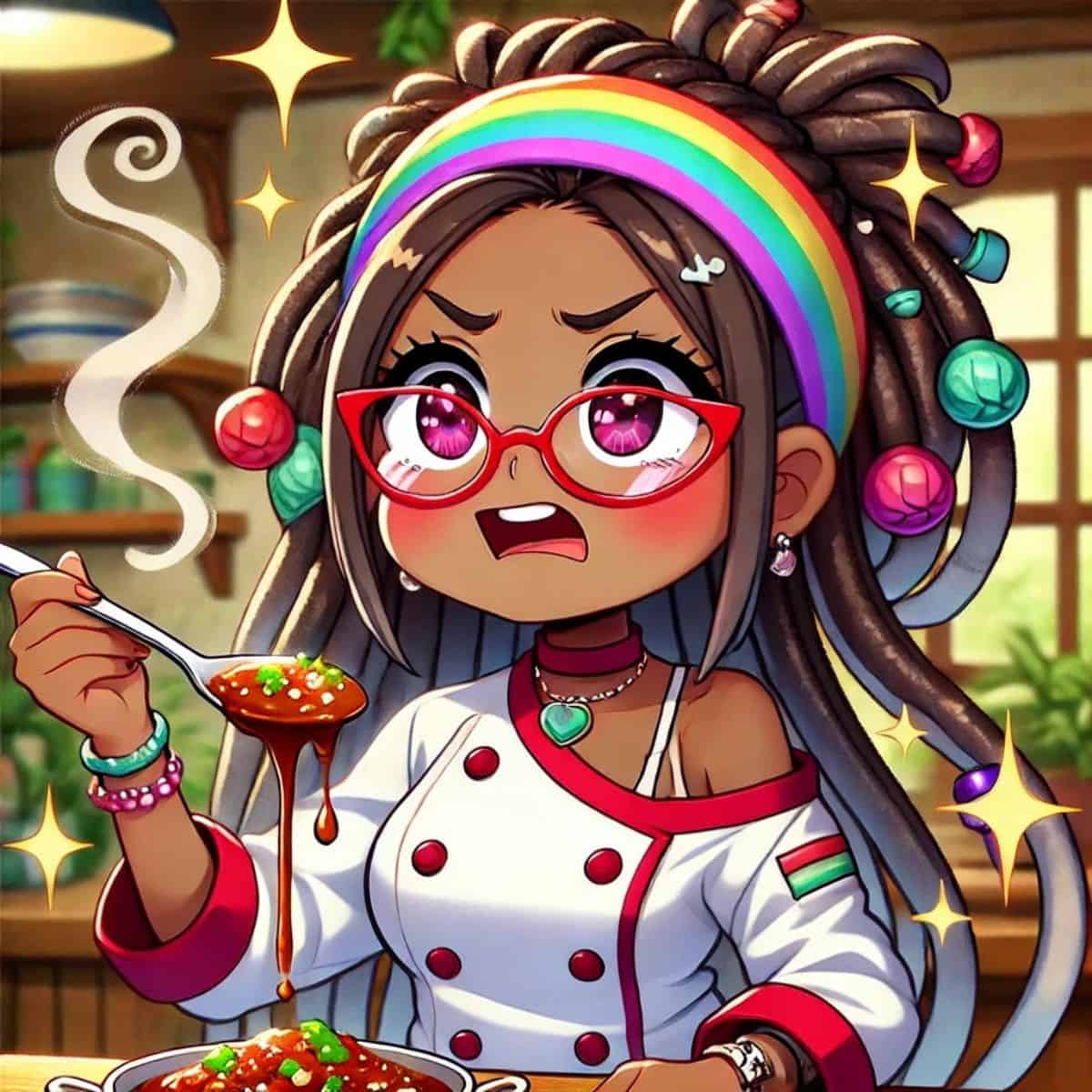Transform your cooking skills and knowledge with sauce-making! From mastering timeless classics to understanding bold global flavors, this guide has everything you need—plus, don’t miss our curated collection of sauce recipes at the end to boost your meal with quick and easy sauce recipes!

Table of Contents
Jump to:
- Unlock Possibilities with Sauce Making
- The 5 French Mother Sauces: A Culinary Foundation
- The World of Sauces: Beyond France in 7 Ways
- What About Vinaigrettes?
- Culinary Glossary
- Cooking with Wine
- Troubleshooting Sauce-Making
- Substitution Guide: Dietary Needs
- 10 Quick Ideas from Staple Pantry Items
- Common Equipment Used
- Storage Tips
- 5 Important Cooking Tips
- Frequently Asked Questions
- What's For Dinner?
- More Cooking Tips
- 📖 Quick and Easy Sauce Recipes
- Subscribe to the YouTube Channel
- Have a Comment or Question?
Unlock Possibilities with Sauce Making
Let me tell you, sauces are like the unsung heroes of every kitchen—those magical remedies that turn your sad, uninspired meals into five-star creations. It can be when you’re whipping up quick and easy sauce recipes to save dinner or experimenting with simple sauce recipes just to flex your culinary chops, the importance of sauces cannot be overstated.
Think of them as your culinary BFFs—always there to rescue a plain piece of chicken or that pile of random veggies lurking in your fridge. Knowing how to make a few fast and easy sauces not only boosts your confidence in the kitchen but also unlocks endless possibilities. With a stash of quick homemade sauces in your arsenal, you’ll feel like a kitchen genius, ready to turn whatever ingredients you have on hand into something magical.
So grab your whisk, channel your inner saucier, and let’s get creative with your next meal!

A saucier is a chef specializing in the art of sauce-making, expertly crafting and perfecting stocks, gravies, and other liquid-based condiments.
The 5 French Mother Sauces: A Culinary Foundation
From elevating a simple dish to channeling your inner Julia Child (The Mother of Cooking Shows!), these sauces will transform your cooking skillz. Ah, the French mother sauces—think of them as the OGs of the sauce world.
Created by French chef Marie-Antoine Carême (NPR: OG celebrity Chef?) and later refined by Auguste Escoffier (My Man! The King of Sauces!), these five sauces—Béchamel, Velouté, Espagnole, Tomato, and Hollandaise—are the building blocks of classic cuisine.
Once you master these, you’ll unlock an entire universe of quick and easy sauce recipes 🤯 and their endless variations. Plus, knowing them makes you sound super fancy at dinner parties—bonus points for that.

Are you looking for authentic French recipes? Check out Le Chef's Wife and Pardon your French.
1. How to Make Béchamel: The Creamy Comfort

If you’re a fan of comforting classics or elegant gratins, Béchamel is your gateway to indulgence. This sauce, also known as white sauce, is the quintessential simple sauce recipe you didn’t know you needed.
This creamy concoction dates back to 17th-century France, where Louis XIV’s court first enjoyed its velvety richness. Making it is as easy as melting butter, whisking in flour to make a roux, and gradually adding milk until smooth.
The result? A luscious, silky sauce with a mild, slightly nutty flavor that pairs perfectly with lasagna (like in the Creamy Spinach Pesto Mushroom Lasagna recipe), mac and cheese, or creamy veggie casseroles.
2. How to Make Velouté: The Elegant Essential
Velouté, a close cousin to Béchamel, dates back to Escoffier’s era and translates to "velvety"—and boy, does it deliver. This quick homemade sauce starts with a blonde roux (equal parts butter and flour cooked until golden) and is finished with a light stock like chicken, veal, or fish.
The result is a delicate, savory sauce with a subtle depth of flavor that works wonders with poultry, seafood, or even as the base for a creamy soup. Think of Velouté as the understated elegance of the sauce world—simple but endlessly versatile.
3. How to Make Espagnole: The Bold Brown Sauce
Espagnole, or brown sauce, is the heavyweight champion of flavor. Born in Escoffier’s kitchen, this sauce is a rich blend of brown roux, beef stock, tomato paste, and mirepoix (onions, carrots, and celery).
Simmer it low and slow, and you’ll end up with a robust, deeply savory sauce that’s the backbone of demi-glace and countless gravy recipes. Its earthy, umami-packed taste is perfect for roasted meats, hearty stews, or impressing your family at Sunday dinner. Just don’t tell them it’s basically a dressed-up gravy—they’ll never know!
4. How to Make Tomato Sauce: The Everyday Hero
Tomato sauce, a universal favorite, has roots in Italian and French cuisine, with Escoffier giving it a refined touch. Simmer ripe tomatoes with onions, garlic, herbs, and sometimes a splash of wine or stock, and voilà—you’ve got a vibrant sauce bursting with tangy sweetness and herbaceous depth, like the Creole Tomato Sauce recipe.
Ideal for pasta, pizza, and braised dishes, this fast and easy sauce is your go-to for weeknight dinners and culinary experiments alike. Its versatility and bold flavor make it a must-have in your recipe arsenal.
5. How to Make Hollandaise: The Buttery Brunch Star
Hollandaise is the decadent sauce that brunch dreams are made of. Created in the 17th century and popularized by Escoffier, it’s a luxurious blend of egg yolks, butter, and lemon juice whisked together over gentle heat. The result? A creamy, tangy, buttery sauce that tastes so velvety rich.

Famous for smothering Eggs Benedict, Hollandaise also elevates steamed asparagus, roasted salmon, and just about anything you want to make feel fancy. Pro tip: Practice makes perfect—this one requires a little finesse!
Recommended Books to Master the French Mother Sauces
If you’re ready to get deeper into the world of quick and easy sauce recipes, there’s no better guide than Mastering the Art of French Cooking by Julia Child. Her approachable explanations and timeless techniques make these sauces accessible to home cooks.
My Rating: ⭐⭐⭐⭐⭐
Purchased:
For a modern twist, try Sauces: Classical and Contemporary Sauce Making by James Peterson—an exhaustive yet engaging reference.
Another must-read is The Flavor Bible by Karen Page and Andrew Dornenburg, which helps you pair your sauces with ingredients like a chef. With these books on your shelf, you’ll become a sauce master in no time.
The World of Sauces: Beyond France in 7 Ways
From tangy tamarind sauce from Southeast Asia to a smoky chili paste from the Americas, exploring international sauces is like taking a flavorful trip around the globe—no passport required.
The French may have perfected the art of sauces, but they’re far from the only culinary geniuses in this department. Around the world, every culture boasts its own signature sauces that bring bold flavors to their dishes.
From fiery spice blends to creamy condiments, sauces are universal culinary tools for adding flavor, texture, and character to meals.
1. European Sauces: Beyond the French Borders
Europe has a treasure trove of sauces that rival the French classics. Take romesco from Spain, for instance—a nutty, smoky blend of roasted red peppers, almonds, garlic, and olive oil that pairs beautifully with grilled fish or veggies.
Italy’s pesto, a vibrant mix of basil, garlic, pine nuts, Parmesan, and olive oil, is a quick favorite for pastas and sandwiches. In Hungary, you’ll find paprikash sauce, a creamy paprika-infused delight, perfect for hearty meat dishes. These quick homemade sauces show how diverse and inventive European cooking can be.

Looking for authentic Spanish recipes? Check out Mama Ía and Spain on a Fork.

2. East Asian Sauces: The Flavorful Base
In East Asia, base sauces are essential to everyday cooking. Chinese soy-based sauces, like hoisin and oyster sauce, bring salty-sweet umami to stir-fries and marinades. Japan's teriyaki and ponzu sauces offer a balance of sweetness, acidity, and savory flavors, while miso paste is the cornerstone of countless dishes.
Meanwhile, in Korea, gochujang—an iconic fermented chili paste—adds depth and spice to everything from bibimbap to stews. These fast and easy sauces are not just condiments—they’re foundational to the bold flavors of East Asian cuisine.

Looking for authentic Korean recipes? Check out Korean Bapsang and My Korean Kitchen.
3. Sauces of North Africa, the Mediterranean, and the Middle East
North African, Mediterranean, and Middle Eastern cuisines offer a medley of vibrant sauces. Tzatziki, a cooling blend of yogurt, cucumber, garlic, and dill, is a Mediterranean staple that perfectly balances grilled meats or falafel, like the Spicy Falafel Pita Sandwich and Lemon Tahini Dressing inspired recipe.
From Yemen comes zhug, a spicy herb paste bursting with cilantro, parsley, and chilies. Harissa, a North African chili paste with smoky, garlicky undertones, is the go-to for spicing up couscous, tagines, or roasted vegetables. These sauces highlight the region’s love for fresh herbs and bold spices.

Looking for authentic Yemen recipes? Check out Sifra and A Yemeniayah's Recipes.
4. West African Sauces: Deeply Flavored Foundations
West African cuisine is built on deeply flavored sauces, with tomato-based stews leading the charge. The base sauce for jollof rice, a mix of tomatoes, onions, peppers, and spices, is both simple and transformative. Learn more with my inspired Spicy Shrimp Farro Risotto with Mushrooms and Peas recipe.
This same base is used for stewed meats, yielding rich, spicy flavors that define the region’s cuisine. Peanut sauce, made with groundnuts and spices, is another favorite, bringing creamy, nutty depth to everything from soups to grilled chicken. This sauce inspired my Spicy Peanut Chicken Wings with Mushroom Jollof Fonio Pilaf recipe.
These sauces are as versatile as they are packed with flavor.

Looking for Authentic Nigerian recipes? Check out Chef Lola's Kitchen and Sisi Jemimah.
5. Caribbean, Latin American, and Mexican Sauces
Caribbean, Latin American, and Mexican cuisines share a love for bold, vibrant sauces. Sofrito, a blend of onions, peppers, garlic, and herbs, is the backbone of many Caribbean and Latin dishes, while mole, a complex Mexican sauce made with chilies, chocolate, and spices, is a flavor-packed labor of love.
Green and red salsas, often made with fresh or roasted chilies and tomatoes, are common throughout the region, adding heat and brightness to tacos, grilled meats, and rice dishes. These sauces celebrate the vibrant, spicy flavors of the Americas.

Looking for authentic Mexican recipes? Check out Pati Jinich and Mexican and Meatless.
6. Middle Eastern Sauces: Hot and Cold Favorites
Middle Eastern cooking boasts a variety of hot and cold sauces that elevate dishes to new heights. Tzatziki (like in Spicy Greek Chicken Meatball Rice Bowl) is a cooling complement to spicy kebabs, while tahini, a creamy sesame paste, is a versatile staple used in hummus, dressings, and sauces. Amba, a tangy mango pickle sauce, brings a sour kick to falafel and shawarma. Try the Spicy Falafel Pita Sandwich and Lemon Tahini Dressing recipe.
For heat lovers, shatta is a chili paste that packs a punch. These sauces blend bold spices and fresh ingredients to create layers of flavor and texture.

Looking for authentic Middle Eastern recipes? Check out Middle Eats and Amira's Pantry.
7. Indian Sauces: A Spice Lover’s Paradise
Whether served hot or cold, Indian sauces showcase the art of balancing spices to create rich, unforgettable flavors. Indian cuisine is synonymous with complex sauces, often shared with its neighboring countries. Curry sauces, whether creamy korma or spicy vindaloo (my ultimate fave!), are built on layers of spices, onions, and tomatoes.
Chutneys—like cooling mint-yogurt or sweet mango—offer a balance of heat and sweetness. Countries like Malaysia and Indonesia who have adopted curry’s influence, creating coconut milk-based sauces with turmeric and lemongrass, inspired my Best Fragrant Creamy Potato Coconut Curry Fish Soup recipe.

Looking for authentic Southern Indian recipes? Check out Swasthi's Recipes and Dassana's Veg Recipes.
What About Vinaigrettes?
Did you know vinaigrettes are technically a sauce? Yep, that tangy, versatile dressing you drizzle over salads is actually part of the sauce family! A vinaigrette is an emulsion—fancy talk for blending oil and acid (like vinegar or lemon juice) into a silky mixture that clings beautifully to food. For example my Rainbow Tuna Salad using a robust and super easy Lemon Dijon Mustard Vinagrette (check it out on Youtube).
It’s not just for greens either; vinaigrettes are magic on roasted veggies, grilled meats, and even as a marinade. But let’s not get ahead of ourselves—this topic deserves its own spotlight, so stay tuned for a full blog post dedicated to the art and science of vinaigrettes!
Still Searching for That Right Recipe?
- How to Make Easy Béchamel Sauce | With Garlic and Onion
- Loaded Cheesy Ground Turkey Red Lentil Pasta
- Quick and Spicy Basil Romesco Sauce: Easy, Fresh, and Flavorful
- Best Air Fryer Caribbean Style Citrus Chicken Wings
- Creole Tomato Sauce Recipe | Easy Spicy Haitian-Inspired
- Simple Spicy Garlic Chili Sauce Chicken Pasta
Culinary Glossary
This section provides concise definitions of certain unfamiliar ingredients and techniques to you understand and improve your cooking skills related to this blog post.
- Roux - A cooked mixture of equal parts flour and fat (usually butter) used to thicken sauces like Béchamel or Velouté.
- Emulsion - A mixture of two liquids (like oil and vinegar) that don’t naturally combine, often achieved through whisking or blending.
- Reduction - The process of simmering a liquid (like a sauce) to concentrate its flavor by evaporating water.
- Mirepoix - A mix of diced onions, carrots, and celery used as a flavor base for sauces and soups.
- Deglaze - The act of adding liquid (like wine or stock) to a pan to lift and dissolve flavorful bits stuck to the bottom after cooking.
- Blanch - Briefly boiling an ingredient, like herbs, to soften or reduce bitterness before incorporating it into a sauce.
- Gastrique - A sweet-and-sour sauce made from caramelized sugar and vinegar, often used to flavor other sauces.
- Beurre Manié - A paste made from equal parts butter and flour, used to thicken sauces toward the end of cooking.
- Tamari - A gluten-free soy sauce alternative often used in Asian-inspired sauces.
- Umami - The savory, “meaty” taste found in foods like tomatoes, soy sauce, and mushrooms, often enhanced in sauces.
Cooking with Wine

When cooking with wine, always choose a bottle that’s good enough to drink—skip the “cooking wine” and opt for flavors you’d enjoy in a glass. Wine adds depth and complexity to sauces, but remember: as it reduces, the flavor concentrates, so go easy on sweeter wines unless that’s the flavor you’re after.
Deglazing pans, creating reductions, or making marinades are all great ways to use wine in your dishes. In summary, deglazing adds depth of flavor.
Wine Pairings and Uses in Sauce-Making
By understanding these pairings, you can enhance the flavor of your dishes while matching the wine’s characteristics to the dish’s style.
- White Grape Wines:
- Riesling: Ideal for a creamy Riesling sauce to pair with roasted chicken or pork, offering a hint of sweetness and acidity.
- Sauvignon Blanc: Perfect for deglazing pans in spicy chicken Bolognese or light seafood dishes, adding bright, citrusy notes. < Main choice since I often cook spicy dish.
- Chardonnay: Great for rich cream sauces, like a beurre blanc for roasted salmon, thanks to its buttery, full-bodied profile.
- Pinot Grigio: A crisp, neutral option for delicate sauces in pasta dishes or shellfish.
- Red Grape Wines:
- Cabernet Sauvignon: A robust choice for hearty sauces in beef stews or lamb dishes, adding deep, tannic flavors.
- Merlot: Perfect for mild, fruity sauces in chicken or duck recipes.
- Pinot Noir: A versatile red for lighter reductions, ideal in sauces for pork or game meats.
- Malbec: Its bold, dark fruit profile enhances tomato-based sauces for pasta or braised dishes.
- Asian Rice Wines:
- Shaoxing Wine (Chinese Cooking Wine): Adds a savory depth to stir-fry sauces, marinades, and braised dishes like red-cooked pork.
- Sake: Perfect for light, umami-packed sauces for seafood or chicken, and great for glazing vegetables or fish.
- Sujung (Korean Rice Wine): Its slightly sweet and tangy flavor is excellent for BBQ marinades and sauces like bulgogi or galbi.
Troubleshooting Sauce-Making

Struggling to perfect your sauce? Don’t worry—this troubleshooting guide will help you fix common sauce-making mishaps like too salty, too thin, or lacking flavor, so you can turn every dish into a masterpiece!
- Too Salty:
- Tip: Balance the saltiness by adding an acid like vinegar, lemon juice, or a splash of wine. Alternatively, incorporate unsalted liquid (like water, broth, or cream) to dilute the flavor, or add a starchy ingredient, like a peeled potato, to absorb excess salt—just remove it before serving.
- Not Enough Seasoning but Don’t Want to Use Salt:
- Tip: Enhance flavor with fresh herbs, spices, or aromatics like garlic, ginger, or onions. A splash of acid (lemon juice or vinegar) or umami-rich ingredients like soy sauce (low sodium), nutritional yeast, or miso paste can also boost taste without relying on salt.
- Too Thick:
- Tip: Gradually thin the sauce by stirring in small amounts of liquid, such as water, stock, milk, or cream, until you reach the desired consistency. Warm the sauce gently while doing this to ensure the added liquid blends smoothly.
- Too Thin:
- Tip: Thicken the sauce by simmering it uncovered to reduce liquid, stirring frequently. For quicker results, whisk in a slurry of cornstarch and cold water or a beurre manié (butter and flour paste) and cook until it reaches the desired thickness.
Substitution Guide: Dietary Needs
If you have dietary restrictions, don’t worry—this substitution guide will help you create delicious dairy-free, gluten-free, and vegetarian sauces that cater to your needs without sacrificing flavor or creativity in the kitchen!
Dairy-Free
Who said you needed dairy to create a creamy sauce?
- Harissa (North African chili paste)
- Chimichurri (Argentinian herb sauce)
- Peanut Sauce (Asian-inspired, made with coconut milk or water)
- Tahini Sauce (Middle Eastern sesame paste)
- Tomato Sauce (classic marinara or spicy arrabbiata)
- Coconut Curry Sauce (rich and creamy using coconut milk)
- Soy Sauce-Based Stir-Fry Sauce
Gluten-Free
Just because you can't have gluten mean you can't indulge in some of the popular sauces.
- Romesco (Spanish red pepper and almond sauce)
- Salsa Verde (Mexican green sauce)
- Hollandaise (buttery sauce made with egg yolks)
- Mango Chutney (sweet and tangy Indian condiment)
- Balsamic Reduction (naturally gluten-free glaze)
- Teriyaki Sauce (made with tamari instead of soy sauce)
- Gochujang Sauce (Korean chili paste sauce, gluten-free versions available)
Vegetarian
- Pesto (traditional basil or variations like sun-dried tomato)
- Tzatziki (Greek yogurt and cucumber sauce)
- Velouté (vegetable stock-based classic sauce)
- Spicy Marinara (tomato-based sauce with a kick)
- Chimichurri (parsley and garlic-based sauce)
- Salsa Roja (Mexican red salsa)
- Coconut Lime Sauce (perfect for veggies or tofu)
10 Quick Ideas from Staple Pantry Items
Make sauces in minutes with simple ingredients you already have. These options show how a little creativity can turn basic pantry staples into culinary deliciousness! How many of these pantry ingredients do you already have?
- Quick BBQ Sauce - Mix ketchup, mustard, brown sugar, and a splash of vinegar.
- Honey Mustard Sauce - Combine mustard, honey, and a little olive oil.
- Sriracha Mayo - Blend mayonnaise and sriracha for a creamy, spicy dip.
- Tartar Sauce -Stir together mayo, chopped pickles, lemon juice, and a dash of mustard.
- Ketchup-Based Stir-Fry Sauce - Mix ketchup, soy sauce (or tamari), a pinch of sugar, and water.
- Simple Vinaigrette - Whisk olive oil, vinegar, mustard, and a touch of honey or sugar.
- Creamy Garlic Sauce - Mix mayo, minced garlic, lemon juice, and a sprinkle of pepper.
- Spicy Ketchup - Combine ketchup, hot sauce, and a dash of smoked paprika.
- Mustard Herb Dressing - Whisk mustard, olive oil, lemon juice, and dried herbs like oregano.
- Easy Cocktail Sauce - Stir together ketchup, horseradish, Worcestershire sauce, and lemon juice.
Common Equipment Used
The Food Processor
A food processor is your go-to for creating smooth, well-blended sauces with minimal effort. It’s perfect for chopping, pureeing, or emulsifying ingredients like nuts, herbs, garlic, or roasted peppers, making it ideal for sauces like pesto, romesco, or even a quick hummus.
The Blender
A blender shines when you’re working with liquid-heavy sauces or need ultra-smooth consistency. Think silky tomato sauce, creamy coconut curry, or a quick hollandaise. Its powerful motor ensures even emulsification and a velvety finish.

Immersion Blender
An immersion blender, also known as a hand blender, is a game-changer for sauce-making, offering convenience and versatility. This handheld tool lets you blend sauces directly in the pot, eliminating the need to transfer hot liquids to a traditional blender (and the mess that often comes with it).
It’s perfect for creating smooth, velvety soups, emulsifying vinaigrettes, or blending creamy sauces like hollandaise right in the pan. Look for one with multiple speed settings and a sturdy blade attachment for the best results. Bonus: it’s compact and easy to clean, making it a must-have for quick and easy sauce recipes!
Whisk
The whisk is essential for hand-emulsifying vinaigrettes, hollandaise, or roux-based sauces. It incorporates air and helps you mix ingredients thoroughly, giving you control over texture and consistency.
Mason Jars
Mason jars are perfect for making and storing vinaigrettes or small-batch sauces. Just add your ingredients, secure the lid, and shake vigorously for a no-fuss emulsion. Bonus: You can store the sauce right in the same jar—minimal cleanup!
Saucepan
The saucepan is your sauce-making workhorse, ideal for simmering, reducing, and creating rich, velvety sauces. A good saucepan should have a heavy bottom to ensure even heat distribution and prevent scorching, like All-Clad, especially for delicate sauces like Béchamel or caramel.
Look for one with a snug-fitting lid to trap steam when needed and a comfortable handle for easy maneuvering. Its depth makes it perfect for sauces that require longer cooking times or larger quantities.
Frying Pan
A frying pan is your best friend when you need to whip up a quick sauce on the fly, just like a pro chef. After sautéing meats or vegetables, you can deglaze the pan with wine, stock, or even a splash of vinegar to create a fast, flavorful sauce using the browned bits (fond) left behind.
Its wide surface area allows for rapid evaporation, making it perfect for reductions or last-minute pan sauces. See examples in branzino with a lemon reduction and chicken breast with a beet reduction recipe. Pair it with a wooden spoon or silicone spatula to scrape up every bit of flavor.
Kitchen Must Haves - Find other tools I use here.

Storage Tips
With these tips, your sauces will stay fresh, flavorful, and ready to elevate any dish!
Refrigerator Storage
- Hot Sauces (e.g., marinara, curry sauce):
- Cool the sauce to room temperature before refrigerating.
- Store in airtight containers or glass jars to prevent spills and retain freshness.
- Use within 3–5 days for optimal flavor and safety.
- Cold Sauces (e.g., vinaigrettes, tzatziki):
- Store in a clean, airtight jar or container.
- Shake or stir before use, as separation may occur.
- Most cold sauces can last up to a week, but dairy-based ones should be consumed within 3–4 days.
Freezer Storage
- Hot Sauces (e.g., tomato sauce, curry base):
- Portion sauces into freezer-safe containers or ice cube trays for individual servings.
- Label with the date and type of sauce.
- Store up to 3 months for the best flavor.
- Cold Sauces (e.g., pesto):
- Avoid freezing dairy-based sauces like tzatziki; they may separate.
- For pesto, freeze in small portions (e.g., ice cube trays), and cover with a thin layer of olive oil to prevent discoloration.
- Use within 2–3 months.
Reheating Tips
- Hot Sauces:
- Thaw frozen sauces in the refrigerator overnight.
- Reheat gently on the stovetop over low heat, stirring to prevent sticking or separation.
- Add a splash of water, broth, or cream to restore consistency if needed.
- Cold Sauces:
- Allow frozen sauces like pesto to thaw in the refrigerator.
- Stir well before use to recombine ingredients.
- Dairy-based sauces are best consumed fresh and shouldn’t be reheated.
Airtight Food Containers - I interchange glass food storage containers with plastic clipping lids or wooden push-ins. I always suggest glass storage containers because they can be microwaved, they hold food without staining, and the glass keeps the food at a more stable temperature, keeping it fresher and longer.
Try the OXO Good Grips Smart Seal Glass Rectangle Food Storage Containers or the Pyrex Freshlock Glass Food Storage Containers.
5 Important Cooking Tips
- Taste! Always taste and adjust seasoning throughout the cooking process to ensure your sauce is perfectly balanced.
- Strain! For a smoother sauce, strain through a fine-mesh sieve or use a blender after cooking.
- Add Citrus! Add acid (like lemon juice, wine or vinegar) at the end to brighten up the flavors in your sauce. You'll notice I often do this in Mediterranean dishes with lemon and lime, with Caribbean dishes, and wine with French dishes.
- Have Patience! Keep your heat low when emulsifying sauces like hollandaise to avoid curdling.
- Finish with Butter! Use cold butter to finish a hot sauce for a glossy, rich texture.
Your Cooking Tips Resource Guide - Become a better home cook with tips to help you cook more efficiently on the Cook's Notebook tab.
Frequently Asked Questions
Your heat was likely too high; use a double boiler or keep the heat low and whisk constantly to prevent the eggs from scrambling.
Thicken it by simmering longer to reduce, adding a roux, or mixing in a slurry of cornstarch and water
Yes, pesto freezes well in small portions (use an ice cube tray), and tomato sauce can be frozen in airtight containers for up to three months
A vinaigrette is a type of emulsion made with oil and acid, often temporarily blended by whisking or shaking.
Reheat slowly over low heat, stirring often, and add a splash of milk or cream if needed to bring back the sauce's creamy consistency,
What's For Dinner?
Looking for recipes for dinner? Try these:
- Quick Spicy Potstickers | Chili Momo Tibetan Style
- Beituti Chicken Shawarma Rice Bowl | Quick and Easy
- Creamy Curry Chicken Gnocchi Soup | Caribbean Style
- Creamy Chicken Corn Chowder with Dumplings | Dairy-Free
More Cooking Tips
Looking for more cooking tips like this? Try these:
📖 Quick and Easy Sauce Recipes






Subscribe to the YouTube Channel
SUBSCRIBE: 👈To my YouTube Channel to Get Notifications of New Videos.
Have a Comment or Question?
We’d love to hear from you! What are your go-to sauces that make your meals shine? Is it a creamy béchamel, a fiery harissa, or a tangy vinaigrette? Share your favorites and tips in the comments below—your ideas might inspire someone else’s next dish! Plus, let us know if there’s a sauce you’d love to learn about, and we’ll make it happen.


















Leave a Reply